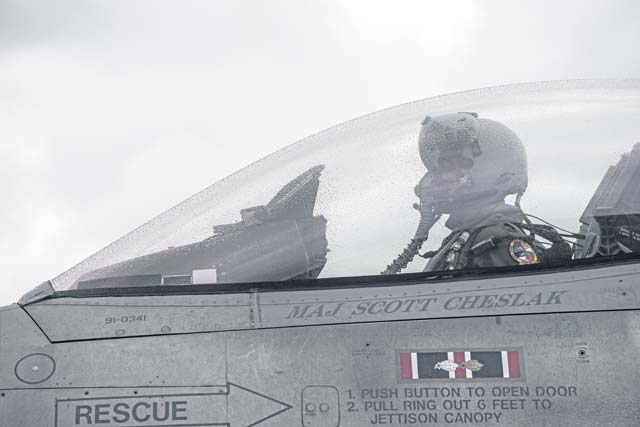
A U.S. Air National Guard captain from the 148th Fighter Wing taxis out in an F-16 Falcon at Amari Air Base, Estonia, June 13 in support of various exercises being conducted in the Baltic region, including Saber Strike and Baltic operations.
RIGA, Latvia — Saber Strike 2014 concluded June 20 with a closing ceremony at the Adazi Training Area here.
This year’s U.S. Army Europe-led, multinational military exercise ran from June 9 to 20 across multiple locations within the Baltic States and comprised approximately 4,700 service members from 10 partner countries.
The Saber Strike exercise program is an ongoing training effort that facilitates cooperation between the U.S., Estonia, Latvia and Lithuania to improve combined operations capability in a variety of missions and prepare participating nations for possible future operations.
Saber Strike 2014 also involved participation from Canada, Denmark, Finland, Norway, Poland and the United Kingdom. Though led by ground forces, this year’s exercise incorporated a significant contribution from U.S. Air Forces in Europe and the U.S. Air National Guard.
“It’s really not just support,” said Brig. Gen. Mark L. Loeben, director of analysis and assessments and senior reserve component adviser to the commander at Headquarters, U.S. European Command. “It is a joint exercise where we exercise the joint force. That’s really not only key to success in the real world, but is also a big part of our training objectives at European Command to exercise the joint force to the maximum extent possible.
“This exercise provides the opportunity for the U.S. Army and Air Force to work together,” Loeben continued. “We also work as a combined force so that if we ever had to take military action as a team, we would be ready.”
During real-world contingencies, the U.S. military services work together in a joint environment to accomplish its missions. Joint exercises, like Saber Strike 2014, provide vital opportunities for U.S. forces to work together and include integrated, total force training with U.S. National Guard units as well as partner nations’ militaries to ensure the national armed forces are interoperable and prepared to maintain regional security and stability.
U.S. Air Force participation in Saber Strike 2014 was nearly doubled from previous years as the exercise increases its joint capabilities. This year, there were over 250 U.S. Air Force active-duty and guard Airmen at three exercise sites in Estonia and Latvia.
The Washington ANG was represented by joint tactical air controllers at the Adazi Training Area, Latvia, working with their partner Latvian JTACS. The 148th Fighter Wing from the Minnesota ANG had eight F-16 Fighting Falcons bed down at Amari Air Base, Estonia, that provided close-air support to ground forces in Adazi. The 127th Wing, Michigan ANG, and the 171st Air Refueling Wing, Pennsylvania ANG, supported the fighters with KC-135 Stratotanker aerial-refueling aircraft.
U.S. Air Forces in Europe provided Airmen form the 435th Contingency Response Group for aerial port capabilities and aircraft maintenance at Amari AB. Additionally, three C-130J Super Hercules aircraft made a historical landing at Lielvarde Air Base, Latvia, as the first U.S. Air Force aircraft to ever land at the former Soviet base. The aircraft brought equipment and approximately 100 Airmen from the 435th CRG to participate in bilateral base-opening training, as well as support the ground forces of the exercise with cargo drops at the Adazi Training Area.
Planning for Saber Strike 2014 officially started about a year ago, but efforts to get the aircraft and forces on the ground at Lielvarde AB began nearly two years ago.
“The idea to bring U.S. aircraft to Lielvarde sparked during a conversation in July 2012,” said Lt. Col Andrew Roberts, bilateral affairs office, U.S. Embassy, Latvia. “The U.S. Air Force needs locations like this to be able to exercise the full spectrum of opening a base, and the Latvian military gets an opportunity to train and practice on what it takes to receive these types of aircraft. It’s a mutually beneficial exercise, and it’s great to see it come to fruition.”
Saber Strike 2014 allowed the U.S., the Baltics and other partner nations to integrate capabilities and interoperability to help sustain our alliance and partnerships.
The integration of air power ensures we are ready to promote the security and stability of the region as a joint force.


